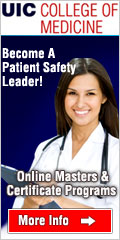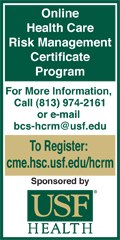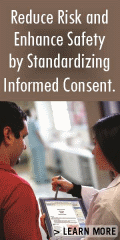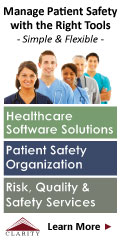 |
 |
 |

July / August 2008

Maintaining Compliance with Joint Commission Medication Management Standards
By Patricia Kienle, RPh, MPA, FASHP;
and John P. (Pat) Uselton, RPh, BS
The Joint Commission's standards for Medication Management (MM) are among the most rigorous and challenging for an organization to implement. To prepare your hospital for compliance, all stages of the medication use process — selection, storage, ordering, dispensing, administration, and monitoring — must be appropriately integrated into a comprehensive medication management system. If a Joint Commission survey finds that a hospital is not in compliance with a standard, the hospital receives a Requirement for Improvement (RFI). To avoid losing Joint Commission accreditation, the hospital must immediately address any RFI and submit evidence of standard compliance within 45 days.
A 2007 survey showed that hospitals were most likely to receive an RFI because of non-compliance with MM standards in three areas: medication storage, medication orders, and pharmacist review of orders (Table 1, pg. 40). These are likely to remain areas of concern for the Joint Commission and should be given particular attention. The CMS Hospital Conditions of Participation and interpretive guidelines should be read to ensure familiarity with the medication standards, because these are the basis of all elements in Joint Commission and state-led surveys.
| Table 1: Top Medication Issues* |
| Standard |
% of hospitals that received RFI |
| MM.2.20 |
Medication Storage |
43% |
| MM.3.20 |
Medication Orders |
20% |
| MM.4.10 |
Pharmacist Review of Orders |
9% |
| *Joint Commission survey conducted January-June 2007, showing percent of hospitals that received a Requirement for Improvement for non-compliance with standard. |
To help hospitals meet the challenge of continuous compliance, Cardinal Health's Center for Safety and Clinical Excellence presents annual "updates" at American Society of Health-System Pharmacists mid-year meetings and recently hosted a nation-wide webcast attended by clinicians at more than 1,100 sites. This article also summarizes important information for hospitals working to comply with the Joint Commission MM standards.
Top Medication Issues
MM.2.20 Medication Storage
Security involves safe storage (e.g., the locking of controlled substances), proper handling, and disposition of drugs. An Element of Performance added after the original 2004 MM Chapter addresses the security of a drug between the time it is dispensed and when it is administered to the patient. Written policies must define what constitutes security and list personnel with authorized access to medications. All controlled substances must be locked and other medications stored safely, with disposition by the end of each shift. Attention should also be paid to anesthesia kits, delivery to patient care and procedural units and other areas, and processes in which medications are not immediately placed into secure storage areas after being delivered by the pharmacy.
Medication safety requires special attention to the storage of concentrated electrolytes, standard concentrations, look-alike/sound-alike (LASA) medications and ready-to-use formulations. The integrity of medications must be safeguarded, either by inspections and written logs, e.g., of storage temperatures, or by technologic means such as electronic logging systems.
MM.3.20 Medication Orders
A complete order includes the patient's name, medication name, strength, route, rate, and dosing frequency. Some hospitals require that orders include a written indication for use; however, each organization is responsible for defining what constitutes a complete order. A hospital must also establish a process for clarifying orders that are incomplete, illegible, or otherwise unclear. Legibility can be enhanced with pre-printed orders (see element 8 of the standard). Clear intent implies the inclusion of the indication for use, precise instructions for PRN specifications, range, titrating or tapering, and requirements for resuming therapy.
Special precautions are required for verbal, telephone, and pediatric weight-based orders, and orders for LASA drugs. Verbal orders must be authenticated within a prescribed time-frame (designated by the institution within state regulations), and staff members who are authorized to accept verbal orders must be clearly identified. Pediatric orders must be carefully written, especially for medications requiring weight-based dosing and calculations. Surveyors place particular emphasis on LASA medications, and each institution is responsible for developing a list of such drugs in the facility. The Joint Commission focus list can help in compiling such a list, and drugs associated with sentinel events or adverse outcomes should also be included.
The entire staff must understand the elements of the medication ordering standard. A policy for incomplete orders must be established and implemented. All orders must be complete, legible, and have clear intent for both indication and distribution of the drug. All pre-printed orders must be complete, and precautions for LASA medications must be clearly identified.
MM.4.10 Pharmacist Review of Orders
In some instances reviews must occur in a pharmacist's absence. For this reason, the Joint Commission allows two exceptions to this standard. First, a licensed, independent practitioner (LIP) can take responsibility for the medication-use process. The scope of an LIP's responsibilities must be clearly defined. Second, in an urgent situation such as a cardiac arrest, when the benefit to the patient clearly outweighs potential risks, a patient may receive drugs prior to pharmacist review.
For institutions lacking 24/7 pharmacy coverage, the hospital must establish processes for order review and for obtaining medications. Reviews may be performed by an offsite company or by another hospital. When the pharmacy re-opens, retrospective order reviews must be performed.
Emergency Department
Initially, the emergency department (ED) was not considered as distinct from the rest of the hospital and was expected to comply with all MM standards. A clarification to this standard permitted an LIP to control medications within the department, but the LIP had to be at the bedside. Because of the unique combination of acute and non-acute issues handled in the ED, new Interim Measures were published in 2007 to permit some allowances to this requirement. A hospital may now define LIP control within the individual institution. Instead of rigid adherence to rules, hospitals are expected to establish a system for control of medications in the ED. Further clarification of Interim Measures, and new Elements of Performance for review of medication orders in the ED are expected within the year.
Radiology/Imaging
The radiology suite also handles medications on a regular basis, often for non-emergent procedures such as computerized tomography (CT) or magnetic resonance imaging (MRI) scans involving contrast media. As with the ED, initially the radiology department was not considered distinct from the rest of the hospital and was required to adhere to the same standards as elsewhere in the hospital. In early 2007, an Interim Measure enabled an institution to define the radiologist's role within the department. Radiologists were given authority to develop protocols to define the role of a radiologist or LIP in managing medications in case of an emergency. The Joint Commission also created specific expectations for contrast agents. Currently, oral contrast can be distributed by authorized competent individuals within the radiology suite, provided this is done in compliance with the interim measures. New Elements of Performance for review of medication orders in Radiology are expected within the year.
Overall, pharmacist review of medication orders remains one of the most complicated standards. Compliance is mandatory whether an order is routine, after-hours, or from the ED, radiology department, or procedural areas such as the post-anesthesia care unit (PACU), dialysis unit or ambulatory surgery center. Interim measures and various allowances within the standard make compliance particularly challenging.
High-Alert Medications
High-alert medications are drugs involved in medication errors with the highest risk of harm. In the United States, 1.5 million preventable adverse drug events and over 100,000 American deaths occur annually (Barclay, 2007; Bond & Raehl, 2006). A first step in improving medication safety is for a hospital to identify its high-alert drugs such as chemotherapy medications, narcotics, and anticoagulants.
2008 and 2009
A 2008 National Patient Safety Goal (NPSG) — 3E — requires organizations to reduce the likelihood of patient harm associated with anticoagulation therapy (Joint Commission, 2008). Anticoagulant safety will continue to be a focus for 2009, as well. Changes to interim measures for the ED and radiology suite are also expected. Other proposed NPSGs for 2009 focus on transfusion care and nosocomial infectious agents such as methicillin-resistant Stapholococcus aureus (MRSA) and clostridium. In addition, the Joint Commission has embarked on a Standards Improvement Initiative. Several chapters, including Medication Management, are expected to be renumbered for 2009. Because medication storage was deficient in almost half of hospitals surveyed, the Joint Commission is likely to continue its emphasis in this area.
Summary
The MM standards for medication storage, medication orders and pharmacist review of orders are associated with the greatest numbers of RIFs and are likely to remain areas of focus for the Joint Commission. Familiarity with each standard's elements of performance and with CMS Conditions of Participation and interpretive guidelines will help prepare for hospital compliance. Particular attention should be paid to exceptions such as those that allow LIPs to control medications so long as a hospital has developed clear policies regarding appropriate procedures and personnel. Most importantly, compliance with both Joint Commission MM standards and CMS Conditions of Participation improves the safety and quality of every stage of medication use.
Patricia Kienle is the director of accreditation and medication safety for the Center for Safety and Clinical Excellence at Cardinal Health. She received her pharmacy degree from the Philadelphia College of Pharmacy and Science, and a master's degree in public administration from Marywood University in Scranton, Pennsylvania. She completed an Executive Fellowship in Patient Safety from Virginia Commonwealth University and is an adjunct associate professor at Wilkes University in Wilkes-Barre, Pennsylvania.
Kienle has served on the Board of Directors of the American Society of Health-System Pharmacists and as President of the Pennsylvania Society of Hospital Pharmacists (PSHP). She also has served on the Pharmacotherapy Specialty Council of the Board of Pharmaceutical Specialties, as the pharmacist member of the Hospital Professional and Technical Advisory Committee of the Joint Commission and on the Board of Governors of the National Patient Safety Foundation. Kienle can be reached at patricia.kienle@cardinalhealth.com
Pat Uselton is the vice president of operations improvement for the Center for Safety and Clinical Excellence at Cardinal Health. Uselton leads the Quality and Regulatory Affairs team, which provides assistance to organizations in preparing for Joint Commission, Centers for Medicare and Medicaid Services (CMS), and other accreditation and regulatory surveys. Their focus is on processes that promote patient safety and the identification and implementation of best practices. Prior to joining Cardinal Health in 1992, Uselton served as the director of operational audit for a hospital management firm. He is co — author of several American Society of Health — System Pharmacist publications including Assuring Continuous Compliance with Joint Commission Standards: A Pharmacy Guide, 7th edition and Preparing to Meet Joint Commission Patient Safety Goals. He is a contributing author to Handbook of Institutional Pharmacy Practice, 4th edition and Competence Assessment Tools for Health — System Pharmacies.
Uselton earned his bachelor's degree in pharmacy from the University of Houston. He is currently a registered pharmacist in Texas and is a member of the American Society of Health — System Pharmacists. Uselton can be reached at pat.uselton@cardinalhealth.com
References
Barclay, L. (2007, August). Hospitals can reduce patient harm related to high-alert medications. Medscape Medical News, Available at http://www.medscape.com/viewarticle/561879
Bond, C. A., & Raehl, C. L. (2006). Adverse drug reactions in United States hospitals. Pharmacotherapy, 26(5), 601-608. Available at http://www.medscape.com/viewarticle/531809
Joint Commission. (2008, March). Hospital comprehensive accreditation manual for hospitals.
Joint Commission International Center for Patient Safety. 2008 Joint Commission National Patient Safety Goals. Available at: http://www.jcipatientsafety.org/15148/
|
 |
 |
 |


















|
 |



